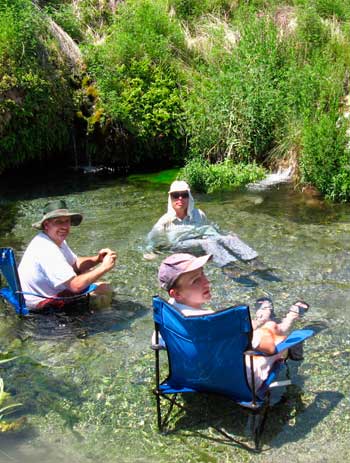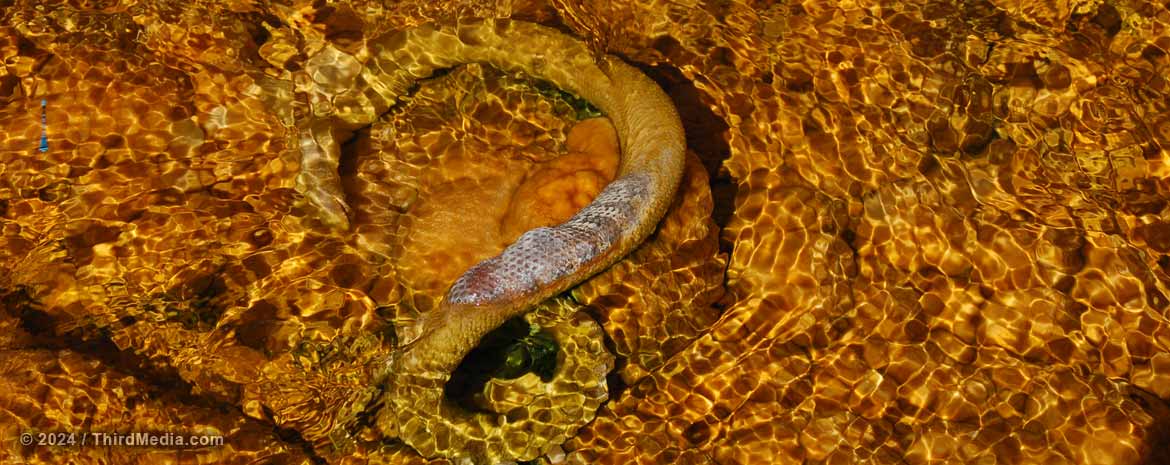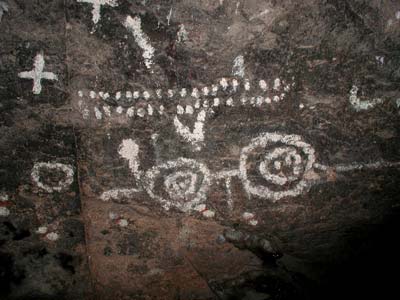
Map coordinates:
39.4603, -114.037
Water temperature:
79.7°F
Site ID:
MI-009

Gandy Warm Springs. Image courtesy of Daniel Veelik, SoCal Grotto.
Gandy Warm Springs is a refreshing oasis of tiny waterfalls, pools, caves, and crystal clear streams with water temperatures up to 81°F. Located on the western edge of Snake Valley, near the Nevada border, the springs are at the base of the southern tip of Spring Mountain (also called Gandy Mountain). The spring water that cascades down the slope of Spring Mountain joins a larger spring that emerges from a cave, initiating the eastward-flowing Warm Creek (also called Gandy Creek). Lush green vegetation, including mosses, watercress, and bright green algae, and animals such as aquatic snails (including the endemic springsnail, Pyrgulopsis saxatilis, found only at Gandy) and the native speckled dace wonderfully stand in stark contrast to the surrounding dry yellow grasses and desert shrubs. Gandy is a popular spot for locals who use the area for soaking, swimming, and baptisms.
Given the small size of Spring Mountain, a cluster of hills extending a mile north-to-south and rising just 1000 feet above the surrounding landscape, as well as the noticeably dry climate, one is amazed when considering the voluminous output of Gandy Warm Springs. Every minute, the springs discharge nearly 9000 gallons of water. In other words, Gandy Warm Springs can fill 20 Olympic-sized swimming pools every day.
Gandy_Warm_Springs.pdf Get Topo Map On the Web New Hotspring Search
All snakes can swim.... but not in scalding mineral water! This one suffered a rather quick fate and is now being calcified into the streambed. Traveling north towards Cherry Creek, Nevada, along the old shelf road on the west side of Steptoe Valley, Monte Neva Hot Springs bubbles up out of the ground at about 175°F. Image courtesy of Matt Bowers / Third Media.
The official event schedule for the 2025 NCKMS has now been updated. Please check our schedule page or download a PDF to your mobile device.

Great Basin National Park Foundation passionately works to enhance, preserve, and interpret the starry night skies, wide-open scenery, cultural heritage, and diverse native ecosystems of Great Basin National Park.
The Foundation is the official non-profit partner of Great Basin National Park.

Burrowed in the Toquima Range in the Humboldt-Toiyabe National Forest, Toquima Cave holds massive cultural importance to Native Americans. This sacred site was utilized by the Western Shoshone tribes as a temporary dwelling between 3,000 and 1,500 years ago.
A large number of pictographs adorn the north and south walls of the cave. As one of many pictograph sites in Nevada, Toquima Cave and the surrounding 40 acres were added to the National Register of Historic Places in 2002.

WCC Ball Cap
Wearing a ball cap? Oh, that's a whole vibe. It's like saying, "I'm strong, but I'm not here for your speleo-approval." It's the kind of quiet power that doesn't scream for attention, but when it walks into the room, everyone knows it's the real deal. No need to flaunt or flex when you've got that kind of effortless strength, right?
Yet, while being grounded and focused on what truly matters, you can still shine at your next grotto meeting by declaring your subtle support of the Western Cave Conservancy!
